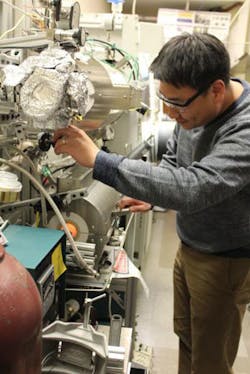Researchers at the U.S. Naval Research Laboratory (NRL) have expanded their knowledge of nanocrystalline ceramic materials while searching for improved ceramic armor. Their work, in quest of stronger, lighter ceramic armor, explores the capabilities of a nanosintering technique that makes it possible to bond nano-sized particles together.
“A few years ago, NRL was the first to show that if you decrease the grain size of ceramics to tens of nanometers, the hardness and strength increase,” said Dr. James Wollmershauser, a materials research engineer in NRL’s Materials Science and Technology Division. “Our current work takes this much further. We decreased the grain size of the fully dense ceramics to record-breaking single digits, and analyzed the elasticity, hardness, energy dissipation, and fracture behavior in ceramics with a wide range of nanosize grains.”
Dr. Heonjune Ryou, a postdoctoral fellow in the U.S. Naval Research Laboratory’s Chemistry Division, operates machinery used in nanocrystalline ceramics research.
“NRL was the first to see the increase of energy dissipation in single digit nano-grain ceramics,” said Dr. Boris Feygelson, a materials research engineer in NRL’s Electronics Science and Technology Division, leading the team’s efforts in nanosintering. “The better the material can accommodate mechanical energy, the better it can stop an incoming threat.”
About the Author
Jack Browne
Technical Contributor
Jack Browne, Technical Contributor, has worked in technical publishing for over 30 years. He managed the content and production of three technical journals while at the American Institute of Physics, including Medical Physics and the Journal of Vacuum Science & Technology. He has been a Publisher and Editor for Penton Media, started the firm’s Wireless Symposium & Exhibition trade show in 1993, and currently serves as Technical Contributor for that company's Microwaves & RF magazine. Browne, who holds a BS in Mathematics from City College of New York and BA degrees in English and Philosophy from Fordham University, is a member of the IEEE.


